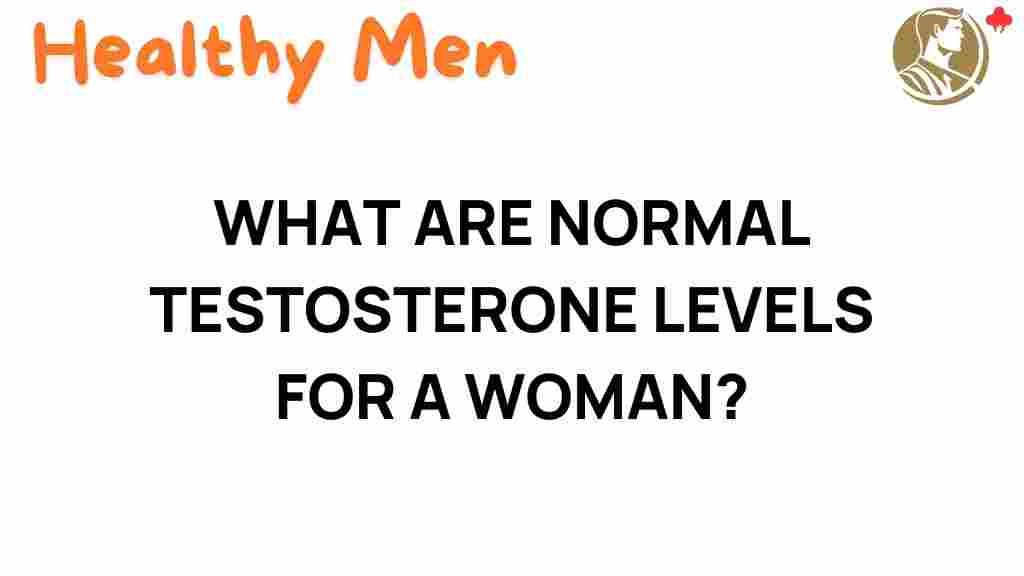Unlocking the Secrets: What Are Normal Testosterone Levels for Women?
When we think of hormones, testosterone often brings to mind images of male athletes and bodybuilders. However, testosterone plays a crucial role in women’s health and wellness as well. Understanding normal testosterone levels for women is essential for maintaining hormone balance, overall health, and fertility. In this article, we will explore the significance of testosterone levels, how they change with age, the symptoms of imbalance, diagnostic methods, and how to achieve optimal hormone balance.
The Role of Testosterone in Women’s Health
Testosterone is commonly known as a male hormone, but it is equally important for women. Produced in the ovaries, adrenal glands, and peripheral tissues, testosterone contributes to various vital functions in women’s bodies, including:
- Regulating libido and sexual function
- Supporting bone density
- Enhancing muscle strength
- Contributing to mood stability
- Aiding in fat distribution
Optimal testosterone levels promote overall health and wellness, making it essential to be aware of what constitutes normal testosterone levels for women.
Normal Testosterone Levels for Women
Normal testosterone levels in women can vary based on several factors, including age and individual health. Typically, the reference range for total testosterone in women is between 15 and 70 ng/dL (nanograms per deciliter). However, it is crucial to understand that these values can differ slightly depending on the laboratory and measurement method used.
How Age Affects Testosterone Levels
As women age, their testosterone levels naturally decline, particularly during and after menopause. The following breakdown illustrates the average testosterone levels by age:
- Teenage years (13-19 years): 20-75 ng/dL
- 20s: 25-75 ng/dL
- 30s: 20-55 ng/dL
- 40s: 15-45 ng/dL
- 50s and beyond: 10-30 ng/dL
These ranges indicate that testosterone levels are typically highest in late adolescence and early adulthood, decreasing with age. This shift can lead to various symptoms and health concerns.
Symptoms of Low Testosterone Levels in Women
Low testosterone levels can lead to a range of symptoms, which may affect a woman’s quality of life. Some common symptoms include:
- Reduced libido or sexual dysfunction
- Fatigue and decreased energy levels
- Loss of muscle strength
- Mood swings, depression, or anxiety
- Weight gain, particularly around the abdomen
- Thinning hair or hair loss
- Bone density loss, increasing the risk of osteoporosis
If you are experiencing any of these symptoms, it may be worth discussing your testosterone levels with a healthcare professional.
Diagnosing Testosterone Levels
To determine testosterone levels, healthcare providers often recommend a blood test. The following steps outline the diagnostic process:
- Consultation: Schedule an appointment with a healthcare provider to discuss symptoms and concerns.
- Blood Test: A blood sample will be taken, usually in the morning when testosterone levels are highest.
- Analysis: The sample will be sent to a laboratory for analysis to measure total testosterone levels.
- Review Results: Your healthcare provider will review the results and discuss them with you.
- Further Testing: If levels are abnormal, additional tests may be necessary to determine the underlying cause.
It’s important to note that testosterone testing might not always provide a complete picture. Other hormone levels and overall health should also be evaluated.
Causes of Low Testosterone Levels
Several factors can contribute to low testosterone levels in women, including:
- Aging: Natural decline in hormone production with age.
- Hormonal Disorders: Conditions such as polycystic ovary syndrome (PCOS) and adrenal insufficiency.
- Medical Conditions: Chronic illnesses like diabetes or thyroid disorders.
- Medications: Certain medications can impact hormone levels.
- Stress: Chronic stress can lead to hormonal imbalances.
Achieving Hormone Balance
Maintaining balanced testosterone levels is vital for women’s health and wellness. Here are some steps to achieve hormone balance:
1. Healthy Lifestyle Choices
Adopting a healthy lifestyle can significantly impact hormone levels:
- Nutrition: A balanced diet rich in whole foods, healthy fats, and lean proteins can support hormone production.
- Exercise: Regular physical activity, particularly strength training, can help increase testosterone levels.
- Sleep: Prioritizing quality sleep is essential for hormone regulation.
- Stress Management: Techniques such as yoga, meditation, and mindfulness can help reduce stress and promote hormone balance.
2. Medical Interventions
If lifestyle changes are insufficient, medical interventions may be necessary. These can include:
- Hormone Replacement Therapy (HRT): For some women, HRT may be an option to help restore testosterone levels.
- Medications: Certain medications can help manage symptoms related to low testosterone.
- Regular Monitoring: Ongoing testing and monitoring of hormone levels to ensure they remain within a healthy range.
3. Consult a Specialist
Working with a healthcare provider specializing in hormone health can provide personalized guidance. You can learn more about hormone balance and treatment options at this resource.
When to Seek Help
If you suspect that you have low testosterone levels, it’s essential to seek medical advice. Your healthcare provider can help determine the best course of action based on your symptoms and test results. Early intervention can prevent potential complications and improve overall well-being.
Conclusion
Understanding normal testosterone levels for women is crucial for maintaining hormone balance and overall health. With age, testosterone levels naturally decline, and this can lead to various symptoms that impact quality of life. By recognizing the signs of low testosterone, seeking proper diagnostics, and making informed lifestyle choices, women can take proactive steps toward achieving optimal health and wellness.
Remember, if you experience symptoms associated with low testosterone, consult a healthcare professional for an accurate diagnosis and personalized treatment plan. Your health and wellness are worth it!
This article is in the category Conditions and created by healthymen Team
